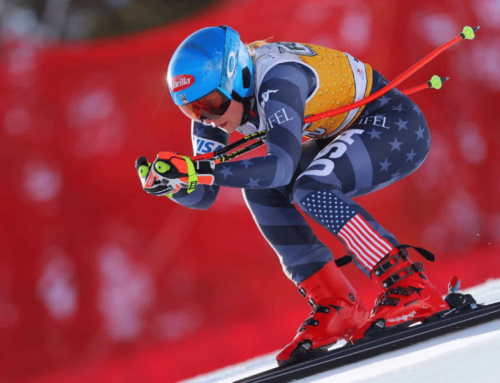How to Be a Ski Racer: Part 2
The road to becoming a ski racer is sometimes a buffed-out groomer, sometimes a mogul field, and sometimes a triple black diamond trip through the unforgiving backcountry. This year we’ll take a look at a few ways kids are finding their way down the unpredictable course of a ski racing career (revisit Part 1 here). Parents, pay attention.
In the spring of 2012, Tahoe native Garret Driller got his first brand-new racing suit — and it was a pretty good one.
He earned it in a friendly wager with fellow Tahoe native Julia Mancuso, with whom he raced in a Pro Am at the U.S, Nationals. “The deal was that anyone who beat Julia got a new suit,” recalls Driller. “She was dating Aksel Lund Svindal at the time, and when I beat her she made him give me one of his suits.”
A few months later, Driller would be wearing another new suit — as a member of the Montana State University Bobcats.
By the end of that season had Driller earned himself his third new suit — as a member of the first-ever National University (N-UNI) Ski Team.
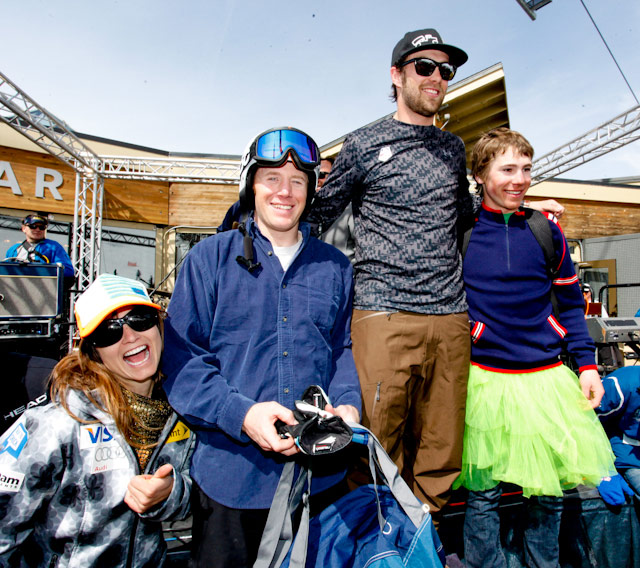
Driller earned a spiffy new speed suit — not the skirt shown here — from fellow Tahoe native Julia Mancuso, at far left.
A True Freshman
That’s the term college coaches use to describe top athletes who go straight from high school to college without competing in another arena first.
And Driller was a true freshman when he began at Montana State University last fall. “It was a pretty easy, logical decision,” he explains. “I’ve always been on the smaller side and never had the strength advantage, so it made sense to physically mature.”
Driller had considered following the path of many of his ski racing peers — taking a PG year to better his points and his chances at a spot on a top NCAA Division 1 team. He’d also been accepted at UVM, the alma mater of his mother, Dee Dee, but would not have a spot on the Carnival team.
It would either be an expensive year, or an unsatisfying one.
Enter Plan C, MSU, where older sister Tenaya is a chemical engineering and math major, and where a spot on the ski team had just opened up. With only six men on the team, Driller would be guaranteed a race spot, and the college racing environment would provide the structure and support to continue developing as a skier at his own pace.
MSU assistant coach Karl Johnson worked with Driller in Squaw Valley as a J3, and remembers his innate ability and touch. “But my favorite part about him was his attitude,” says Johnson. “He was always positive and out there because he wanted to be there. He loved to ski and have fun.”
That’s something Johnson appreciated from his own upbringing in Richmond, Vt., at his famously homegrown club, Cochran’s. Like Driller, Johnson pursued multiple sports instead of summer skiing, and thrived on a dialed-back approach. “At Cochran’s, skiing and training was fun,” says Johnson. “Not work.”
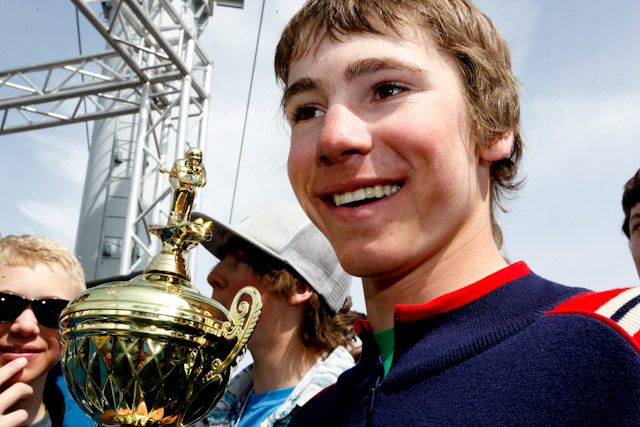
Driller’s positive attitude wins him acclaim among coaches. USSA Photo.
The Organic Route
Dee Dee and Ron Driller, competitive athletes in skiing and biking, respectively, wanted their kids to grow up appreciating not only sports but also art, music and, of course, education.
“We made a conscious decision not to eat and breathe any one thing, including skiing,” Dee Dee explains. To ensure a range of exposures, they spent their resources carefully. Dee Dee coached Mighty Mites so her kids could be in the program, first at Alpine Meadows and then at Squaw Valley. Ron made rational and disciplined decisions about everything from ski prep to expenses to bedtimes.
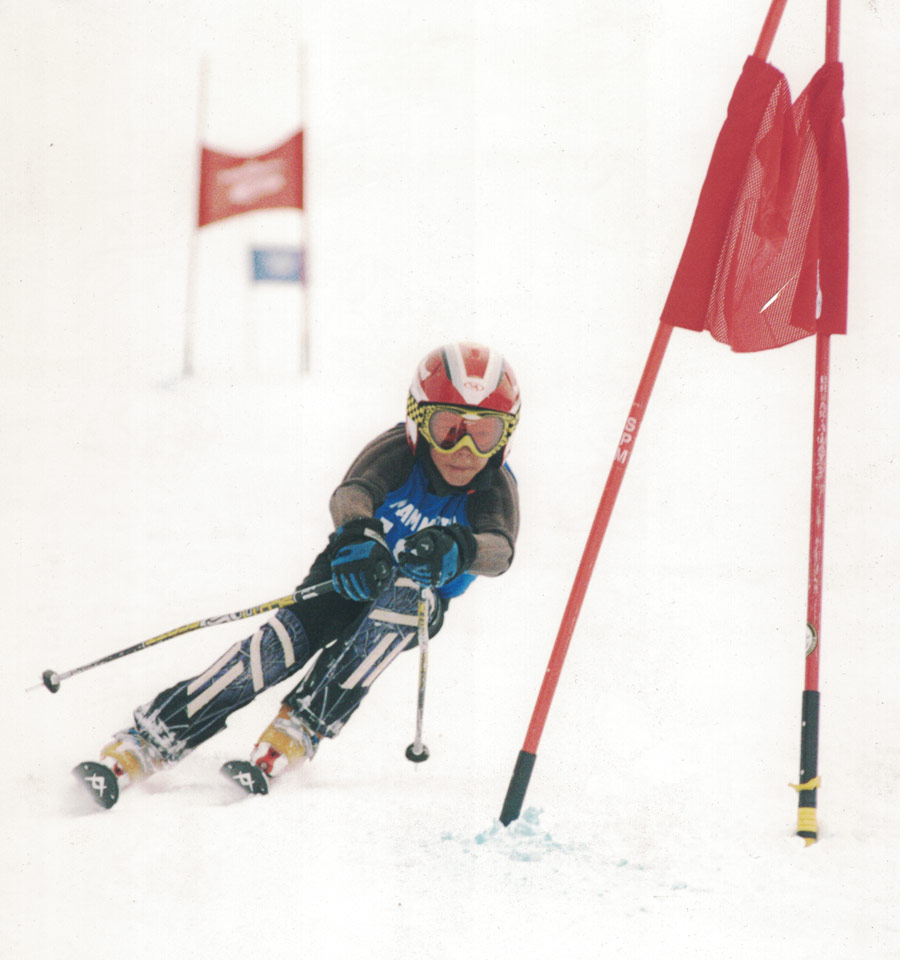
When your mom’s a Mighty Mites coach, you might ski like this.
Along the way, the Drillers did what made sense. The kids grew up on hand-me-down clothes and gear. Instead of chasing summer camps, Garret and Tenaya spent their summers in Tahoe mountain biking, hiking and paddleboarding or working at their mother’s catering company. When they did go to Mount Hood, they did it as a mini vacation.
“Everywhere you look, at every activity, there’s a way to pay top dollar for it, and a way to let it happen organically,” says DeeDee. “We definitely took the organic route.”
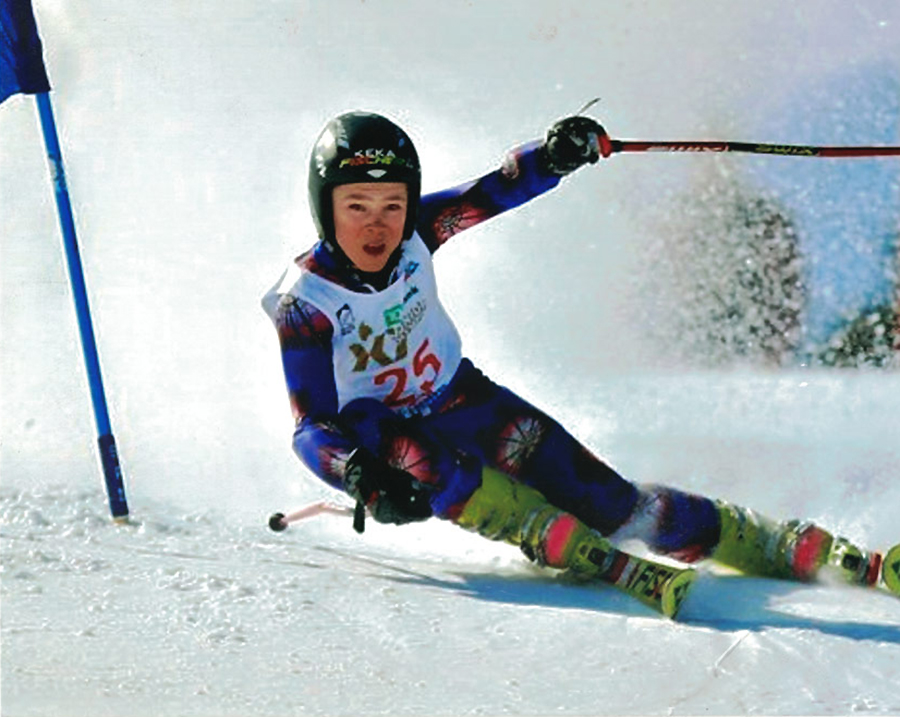
The organic route paved the way for Driller to conquer the course.
At 13, the minimum age to apply for the Far West Masters Scholarship Program, both kids sent it their paperwork. The program subsidizes racing and training fees, and provides early season training at Copper Mountain in exchange for fundraising help, forerunning masters races and speechmaking at the annual awards banquet.
Eddie Mozen, the chairman of the Far West Masters Scholarship Program, has known Garret and Tenaya since they were tots. “They’re both great kids,” says Mozen. “By the time he was eligible to apply for scholarship money, Garret was already an active participant in the program, selling raffle tickets and volunteering for yard clean-up.”
Linking It Together
The Driller work ethic came in handy on the college circuit, where mixing mechanical engineering curriculum and a full ski racing schedule is a challenge.
“It’s doable, but doesn’t leave time to lounge around,” says Driller, who had never belonged to a gym, let alone follow a rigorous, structured weight program with a strength coach.
Johnson believes Driller’s success last season had everything to do with strength and the confidence that goes with it. “He still had that wild flavor,” says Johnson, “but the strength let him be consistent.”
The college racing schedule also meshed well with Driller’s own slow-starting form, which tends to reach peak freshness in March, when many competitors are overcooked.
Strength, style and timing all came together at the 2015 NCAA Western Regional Championships in Alaska, where, in two runs of linked recoveries, Driller became the first Bobcat to win an NCAA West Regional slalom title. By the end of the season, Driller had won Rookie of the Year among all MSU athletes — and one of six coveted spot on the first ever N-UNI Ski Team.
Garret Driller executes winning runs at NCAA Regionals with his own wild style and athleticism.
The New UNI Team Frontier
How Driller’s time on the N-UNI team will play out is not entirely clear. UNI Ski Team Coach Peter Lange explains that in the program, athletes commit to the summer dryland training at the Center of Excellence in Park City and attending two on-snow camps.
From Oct. 17 through mid-December, UNI racers have access to as much training and racing as they can manage with their academic responsibilities. Throughout the season, they’re expected to represent the UNI Ski Team in all NorAm and Nationals races in their respective specialties.
When with the UNI Team, athletes pay for airfare, housing and meals, but are permitted to travel with their schools if it’s a cheaper or better option.

Driller fuels up for training at Copper Mountain.
Lange is refreshingly candid on the experimental nature of the new endeavor, fully expecting the program will need tweaking along the way. “You do your best to try to get it right, be honest about what worked and what didn’t and move on from there,” he says. “That’s going to be truer than ever in the UNI team.”
Lange is excited about the development, as are Driller’s college coaches. “I see it as 100-percent positive,” says Johnson, who, along with head coach Kevin Francis, skied four years for Dartmouth. “We are focused on the goal of the athlete. If that extends beyond the college circuit, we will support that. I also hope there is still the option for the 100-percent college skier, because the student-athlete thing is a great life experience.”
“It lets some air out of the balloon,” says Lange about the UNI program creating a less stressful and more productive atmosphere for development. “For the right kid, it takes away the anxiety that goes along with all the eggs being in one basket.”
Driller, now 19 years old, seems to be one of the right kids. “I want to do well in the NorAms and UNI races, lower my points and see how far I can make it — World Juniors would be amazing,” he says, shrugging off pressure to re-qualify for the N-UNI Ski Team. “I’m comfortable with where I am and positive about my skiing. I want to continue my education — nobody hits their peak until much older.”
Sure, the schedule this season will be a challenge, admits Driller. (So will remembering which of those suits to wear.) And if at some point along the way he earns a World Cup start and needs to take a break from college? Says Driller with his dry sense of humor and humility, “That would be acceptable.”
